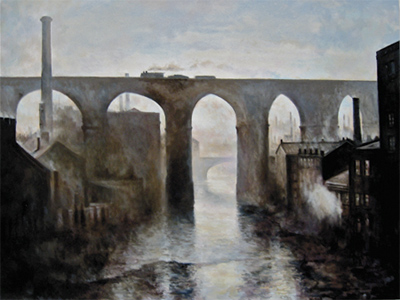
When Lawrence Gipe first saw the industry ad that was to become the basis for his new painting, Rosemont Copper Girl, he knew what he was looking at. "I've been studying propaganda for thirty years," Gipe said. "With her blond braids and skyward gaze, she could have been a Hitler Youth." The painting depicts a girl in braids, holding a solar panel (made with copper), standing in front of windswept mountains. The ad was produced by the PR agency defending the embattled Rosemount Mine, an open pit excavation on the edge of Tucson, Arizona, that is under EPA permit review. Concerns of local citizenry of inevitable fine red dust storms of mine tailings descending on the desert city are being combated with images that promote home, patriotism, and politically correct hopes for the future.
This is the first painting by Gipe that has appropriated a contemporary image, but it follows a journeyman's long output of studies that critique the subtle side of propaganda and advertising. Gipe is known for his masterful oeuvre of oil paintings and graphite drawings that can easily overwhelm the viewer with their high technique--his deft facility in rendering a range of high realist styles. Sourcing photographs mostly from the 1930s to '60s, Gipe has created a paean to the Modern Age, an era of future-focused optimism. Or so it seems.
Born in Baltimore in 1962, Gipe studied at Virginia Commonwealth University and received his MFA from Otis/Parsons School of Design in 1986. His work is in numerous collections including LACMA, Yale University and the Brooklyn Museum of Art. Before moving to Tucson several years ago to teach painting at the University of Arizona, Gipe lived in and around Los Angeles. His recent retrospective, "Approved Images: Lawrence Gipe," was at Tucson Museum of Art.
Gipe's dramatic paintings are seductive, high in chiaroscuro, and deliver a visual thrill with the efficiency of the best film noir effects. Rushing locomotives, steaming factories, and soaring cityscapes are joined by touching scenes of domesticity and muscle-taught athletes to describe a time when desires for bodily perfection, proper sentiment, and national aspirations were one. In his work, both the past and the future are embraced as a refuge from the unpleasant sloppiness of the present. Gipe has chronicled, through his historic studies, how sentimental depictions of love and home have been aligned with triumphal displays of industrial hypermodernity to lull the viewer into a state of compliance to the message. Almost any of his works can be read simply, but combined with their titles and seen together as a series, a warning ensues.
Many of his images were culled from Nazi-era Germany books of photography, but Gipe also depicts images of heroic Americana. Panel No. 5 of Amerika (Penn Station, 1938), (2000), depicts the now-destroyed monumental building as a cathedral, its interior awash in downward-cast light from windows on high. An ode to a lost modern treasure, but chillingly so; the photo on which the painting is based was taken by a Nazi photographer, intent on locating targets of war. Penn Station fell eventually, not to attacking Germans, but to urban renewal. Another scene depicts an almost Turner-esque view of morning breaking rapturously over water onto edifices of a Mediterranean town. The conjuring trick is eerily appropriate, as Sicily 1944 (Dawn after the raid), (1998), does indeed evoke destruction.
While Gipe's paintings of 1930s athletes may bring to mind the problematic aesthetics of Leni Riefenstahl's films, it is not her notorious 1934 Triumph of the Will that comes to mind, but instead, strangely, her later redemptive book, Last of the Nuba (1973), resplendent in African beauty. Perhaps this is the Rosemount Girl speaking up. She's a good one, no Nazi, but American as apple pie.
Trust her, won't you?
The exhibition "Approved Images: Lawrence Gipe," was on view at the Tucson Museum of Art, from February 12 - June 12, 2011. www.tucsonmuseumofart.org
This article was written for and published in art ltd. magazine ![]()
